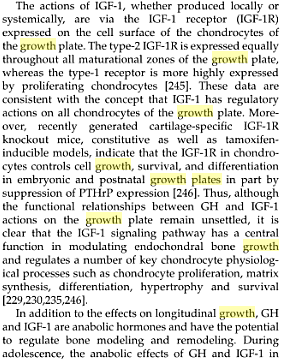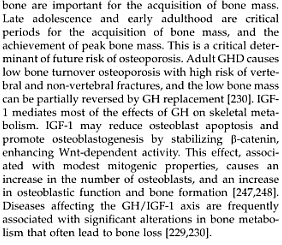Something that I have also been interested about for a long time was to ask whether we could possibly alter or increase the number of insulin growth factor receptors in the growth plates to possibly increase height.
The thing I have learned so far is that the effect of IGF-1 is both systemic and local in nature. Also it seems that both the hGH and the IGF-1 both can work to stimulate the growth plate chondrocytes from the study “IGF-Independent Effects of Growth Hormone on Growth Plate Chondrocyte Function”
From the Wikipedia article on the Insulin-like Growth Factor 1 Receptor…
“…is a protein found on the surface of human cells. It is a transmembrane receptor that is activated by a hormone called Insulin-like growth factor 1 (IGF-1) and by a related hormone called IGF-2. It belongs to the large class of tyrosine kinase receptors. This receptor mediates the effects of IGF-1, which is a polypeptide protein hormone similar in molecular structure to insulin. IGF-1 plays an important role in growth and continues to have anabolic effects in adults – meaning that it can induce hypertrophy of skeletal muscle and other target tissues. Mice lacking the IGF-1 receptor die late in development, and show a dramatic reduction in body mass, testifying to the strong growth-promoting effect of this receptor. Mice carrying only one functional copy of igf1r are normal, but exhibit a ~15% decrease in body mass.”
From PubMed study “IGF-1R signaling in chondrocytes modulates growth plate development by interacting with the PTHrP/Ihh pathway.”
Abstract
Systemic derangements and perinatal death of generalized insulin-like growth factor 1 (IGF-1) and IGF-1 receptor (IGF-1R) knockout mice preclude definitive assessment of IGF-1R actions in growth-plate (GP) chondrocytes. We generated cartilage-specific Igf1r knockout ((Cart) Igf1r(-/-)) mice to investigate local control of chondrocyte differentiation in the GP by this receptor. These mice died shortly after birth and showed disorganized chondrocyte columns, delayed ossification and vascular invasion, decreased cell proliferation, increased apoptosis, and increased expression of parathyroid hormone-related protein (Pthrp) RNA and protein in their GPs. The increased Pthrp expression in the knockout GPs likely was due to an increase in gene transcription, as determined by the increased activity of a LacZ reporter that was inserted downstream of the endogenous PTHrP promoter and bred into the knockout mice. To circumvent the early death of (Cart) Igf1r(-/-) mice and investigate the role of IGF-1R during postnatal growth, we made tamoxifen (Tam)-inducible, cartilage-specific Igf1r knockout ((TamCart) Igf1r(-/-)) mice. At 2 weeks of age and 7 to 8 days after Tam injection, the (TamCart) Igf1r(-/-) mice showed growth retardation with a disorganized GP, reduced chondrocyte proliferation, decreased type 2 collagen and Indian Hedgehog (Ihh) expression, but increased expression of PTHrP. Consistent with in vivo observations, in vitro knockout of the Igf1r gene by adenoviral expression of Cre recombinase suppressed cell proliferation, promoted apoptosis, and increased Pthrp expression. Our data indicate that the IGF-1R in chondrocytes controls cell growth, survival, and differentiation in embryonic and postnatal GPs in part by suppression of Pthrp expression.
Analysis & Interpretation:
We see from the Abstract that the IGF1R is needed for at least the formation of the organization of the chondrocyte columns which is absolutely critical for the formation of any length of bone, to get the timing of ossification correctly, cell proliferation, and a slow rate of chondrocyte apoptosis. It seems that when mice which are bred to have the IGF1r gene knockout caused quick death. All of the essential chondrocyte and growth plate compounds like collagen type II, Ihh, were all lower but the PTHrP expression was higher. This result is surprising to me because of a previous post where I wrote that maybe the way to cause regenerated growth plates was to use the higher expression of PTHrP. Maybe I was wrong in believing that increased PTHrP was a good thing.
Implications:
This post shows the real reason why it is important to study every and learn as much as possible about the system we are looking at because the information from one study may correct, disapprove, and change our previous wrong assumptions and ideas. At this point, I would have to say that PTHrP expression may not be useful for chondrocyte proliferation, column formation, etc.
From the Technical Book “Pediatric Bone: Biology & Diseases” pg. 72 by Francis H. Glorieux, John M. Pettifor, Harald Jüppner I have taken 2 clips of the information. It shows that the receptors of the IGF-1 is found on the cell surface of the chondrocytes of the growth plate.
There is 2 types of IGF1R, Type 1 and Type 2. The type 1 is found mostly in the proliferative zone of the growth plate while the Type 2 type is found in all of the zones of maturation in the growth plate. It would seem that there is some ability in the IGF1R in suppresion PTHrP (Parathyroid hormone related protein) expression.



Pingback: Complete List Of Posts - |